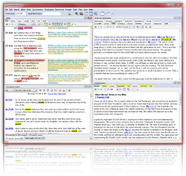Beetle
Beetle
(חִרגֹּל chargol', q. d. "leaper") occurs only in Le 11:22, where it is mentioned as one of four flying creeping things, that go upon all four, which have legs above their feet to leap withal upon the earth, which the Israelites were permitted to eat. The other three are the locust, the bald locust, and the grasshopper, respectively rendered by the Sept. Βροῦχος, ἀττάκη, and ἄκρις, while they translate chargol by ὀφιομάχης (q. d. "serpent-fighter"), which Suidas explains as being a wingless locust (εϊvδος ἀκρίδος, μὴ ἔχον πτερά). Pliny (9:29) and Aristotle (Hist. Anim. 9, 6) mention locusts that. are serpent-destroyers. This Hebrews word cannot mean the beetle. No species of scarabaeus was ever used as food by the Jews, or perhaps any other nation. Nor does any known species answer to the generic description given in the preceding verse: "This ye may eat of every winged creeper which goeth upon four (feet); that which hath joints at the upper part of its hind legs, to leap with them upon the earth" (comp. Niebuhr, Descrip. de l'Arabie, Copenhague, 1773, p. 33). Hence it is plain that the chargol is some winged creeper, which has at least four feet, which leaps with its two hind jointed legs, and which we might expect, from the permission, to find actually used as food. This description agrees exactly with the locust-tribe of insects, which are well known to have been eaten by the common people in the East from the earliest times to the present day. This conclusion is also favored by the derivation of the word, which signifies to gallop like the English grasshopper and French sauterelle. Although no known variety of locust answers the above description of Pliny and Aristotle, and, indeed, the existence of any such species is denied by Cuvier (Grandsaque's ed. of Pliny, Par. 1828, p. 451, note), yet a sort of ichneumon locust is found in the genus Truxalis (fierce or cruel), inhabiting Africa and China, and comprehending many species, which hunts and preys upon insects. It is also called the Truxalis nasutus, or long. nosed. May not, then, this winged, leaping, insectivorous locust, and its various species, be "the chargol, after its kind," and the ὀφιομάχης of the Septuagint? or might the name have arisen from the similarity of shape and color, which is striking, between the Truxalis nasutus and the ichneumon; just as the locust generally is, at this time, called cavalette by the Italians, on account of its resemblance in shape to the horse? We know that the ancients indulged in tracing the many resemblances of the several parts of locusts to those of other animals (Bochart, Hieroz. pt. 2, lib. 4, c. 5, p. 475). It may be observed that it is no objection to the former and more probable supposition, that a creature which lives upon other insects should be allowed as food to the Jews, contrary to the general principle of the Mosaic law in regard to birds and quadrupeds, this having been unquestionably the case with regard to many species of fishes coming within the regulation of having "fins and scales," and known to exist in Palestine at the present time—as the perch, carp, barbel, etc. (Kitto's Physical History of Palestine, article Fishes). The fact that the chargol is never made the means of the divine chastisements (for which purpose a locust preying upon insects could scarcely be used), concurs with this speculation. SEE LOCUST.
The beetle, however, was very common in Egypt, and is the species called by Linnaeus Blatta Egyptiacus, thought by many to be mentioned in Ex 8:21, etc., under the name עָרֹב, arob', where the A. V. renders it "swarms of flies." SEE FLY. Beetles are, by naturalists, styled coleopterous insects, from their horny upper wings, or shard; the species are exceedingly numerous, differing greatly in size and color, and being found in almost every country. The order of Coleoptera is divided into many families, of which the scarabaeidae and blattae, or common beetles and cock-chaffers, are known to every one. These creatures, like many others in the insect world, deposit their eggs in the ground, where they are hatched, and the appearance of their progeny rising from the earth is by some writers supposed to have suggested to the Egyptian priesthood the doctrine of the resurrection of the dead. Certain it is that beetles were very common in Egypt, and one of them, thence styled by naturalists Scarabaeus sacer, was an object of worship; and this fact gives strength to the conjecture that this creature is meant in Exodus 8, as the sacred character of the object would naturally render its employment as a plague doubly terrible. Besides its being worshipped as a divinity, stones cut in the form of the beetle served as talismans among the Egyptians. The under surface was filled with figures cut in intaglio of solar, lunar, and astral symbols and characters. They were held, according to Pliny, to inspire the soldier with courage, and to protect his person in the day of battle, and also to defend children from the malign influence of the evil eye. There is little reason to doubt that the Hebrews learned the use of these things in Egypt, but they were prohibited by the Mosaic law. The Gnostics, among other Egyptian superstitions, adopted this notion regarding the beetle, and gems of gnostic origin are extant in this form, especially symbolical of His (q.v.).

